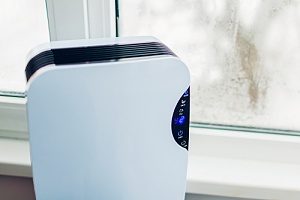Presidential Heating & Air Conditioning
Gaithersburg HVAC Contractors
 The right level of humidity in your home is important for your comfort. It is also important for your health. If the humidity is too high, you can have problems with rotting wood, mold and allergies, but if it’s too low, you can experience dry skin and annoying static electricity. A humidity level that is around 50% and no higher is the ideal indoor humidity in winter to maintain in your home during the cold months. However, the humidity level may need to be adjusted depending on the outdoor temperature.
The right level of humidity in your home is important for your comfort. It is also important for your health. If the humidity is too high, you can have problems with rotting wood, mold and allergies, but if it’s too low, you can experience dry skin and annoying static electricity. A humidity level that is around 50% and no higher is the ideal indoor humidity in winter to maintain in your home during the cold months. However, the humidity level may need to be adjusted depending on the outdoor temperature.
Maintaining The Ideal Indoor Humidity in Winter
Here are some guidelines for the most ideal indoor humidity in winter based on the outdoor temperature:
When outdoor temperatures are between:
- 20˚F and 50˚F, indoor humidity levels should be less than 40%
- 10˚F and 20˚F, indoor humidity levels should be less than 35%
- 0˚F and 10˚F, indoor humidity levels should be less than 30%
- -10˚F and 0˚F, indoor humidity levels should be less than 25%
- -20˚F and -10˚F, indoor humidity levels should be less than 20%
- At -20˚F or lower, indoor humidity levels should be less than 15%
In the winter, however, the humidity levels tend to be too low. Low humidity leads to other problems. Keeping the humidity level balanced in your home mitigates static electricity in the winter, protects your wood floors and furniture against cracking, reduces unhealthy contaminants such as mold, mildew, and bacteria, and makes your home more comfortable overall.
Carrier® Ideal Humidity™ Technology
Get the Guide
Carrier® Ideal Humidity™ Technology
Get the Guide
Use a Humidistat in Winter
To improve the humidity levels in your home in the winter and improve the indoor air quality, you need a humidifier. You can have a whole-house system installed that operates as a humidifier in winter and dehumidifier in the summer. This component is connected with your central HVAC system.
A centralized whole house system will operate with a humidistat. A humidistat is a device that measures the amount of moisture in the air. The device itself consists of a sensing element that is composed of a flat plate fitted with alternate metal conductors. Attached the sensing element is a relay amplifier, which reads signals sent by the sensing elements to give accurate humidity levels.
How A Humidistat Works
The humidistat works by causing an electrical resistance between the conductors mounted on the sensing element based on the amount of humidity in the air. The relay amplifier measures the resistance. Based on that measurement, the humidistat turns the humidifier on if the electrical resistance shows the air is too dry or turns off the humidifier once the ideal indoor humidity level is achieved. The humidistat will automatically adjust the valves, dampers or other switches of the HVAC system to regulate airflow and control the humidity throughout your home.
The Benefits Of a Humidistat
Even in humid regions of the country, a humidistat in the winter months makes the indoor air more comfortable. You will feel warmer without having to keep turning up the heat. When the air has achieved the right humidity level, the humidistat will signal the humidifier to turn off the vapor.
A humidistat is important to keep the air from becoming too moist. If it becomes too humid, water or ice will appear on your windows. If there's moisture on the windows, chances are high that it is also forming in your home’s walls and attic. Over time, the woodwork throughout your home will begin to rot. This leads to mold infestations and costly repairs.
Using A Portable Humidifier
If you don’t need a whole-house system, you can acquire a portable humidifier. A portable humidifier usually comes with a humidistat. The attached humidistat will ensure that you do not over-humidify the room. It will effectively monitor and control the humidity in the air near the machine, but it will not measure the humidity in other parts of the home. For that, a hygrometer is useful, though a hygrometer will not control the humidity level as a humidistat does.
Using a Humidistat to Control Your A/C
You can also wire a humidistat into your thermostat. It will run your air conditioner to control the humidity level inside the house independently of temperature. The humidistat will not let the air conditioner turn on if the temperature is high but the humidity level is low. When the indoor humidity level gets into an unacceptable range, the humidistat can run the air conditioner until the humidity level is reduced. Using a humidistat this way lets you maintain the desired levels of humidity in your home while you are away without having to run the HVAC system more than is needed.
Contact a Professional HVAC Contractor
The climate conditions where you live will dictate the amount of humidity inside your home. Regardless of where you live, a humidifier in the winter will help you keep the ideal indoor humidity in winter, and a humidistat will monitor the humidity levels and control the system’s operation. Professional HVAC Contractors can advise you on the benefits of air quality control appliances such as a humidifier and give you recommendations on the best system for your home. Contact a reputable HVAC contractor for a free estimate.


